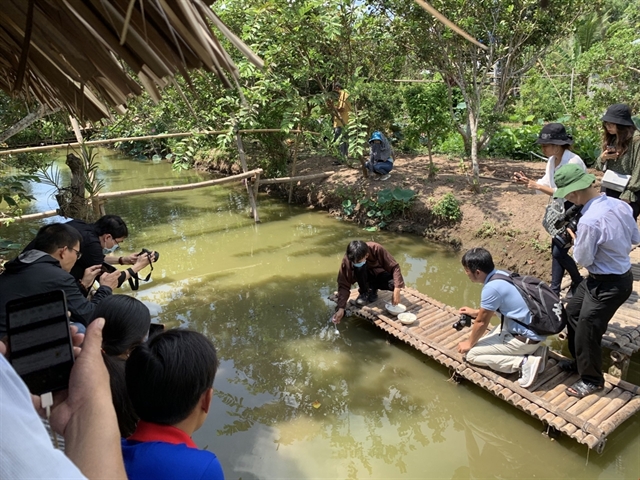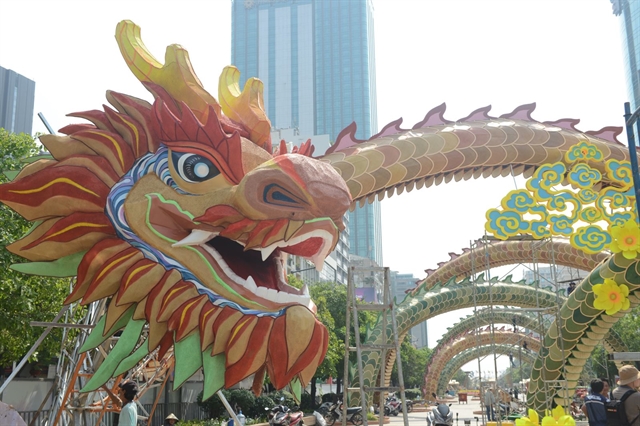 Sunday/Weekend
Sunday/Weekend

 |
| Cồn Sơn in Cần Thơ is famous as a favourite ecotourist destination. VNA Photo |
The Tết (Lunar New Year) holiday recorded impressive results in tourism and service activities in many localities.
Highlights have been experiential activities and exploration of the distinctive cultural features in each locality, which have increased the attractiveness of the destinations.
After a new year trip to Cà Mau and Cần Thơ, tourist Đinh Ngọc Trang from Hà Nội appreciated the opportunity to learn about traditional customs and how people in the Mekong Delta region usually decorate their houses with trays of fruits and pots of flowers and prepare various traditional dishes.
At the community tourism destination Cồn Sơn in Cần Thơ City, for the first time, Trang learned how to mix coloured water to create a purple hue for bánh tét (sticky rice cake) made from magenta leaves or to wrap the cake with fillings made from banana, salted eggs and ginseng, which was very unique.
Assessment of tourism activities during the holiday by representatives of the tourism industry in many localities indicates that the distinctive local cultural features expressed through Tết customs, religious rituals, ancestor worship, cultural and historical heritage, people's daily lives, and local culinary specialties are prominent ingredients that make up tourist products attracting domestic and international visitors.
The more unique and distinctive the local culture, the more memorable and profound the tourists' experiences.
HCM City, honoured as Asia's leading festival and event destination within the framework of the World Travel Awards 2023, had many events that attracted a large number of tourists during Tết, such as the Lunar New Year Flower Market along the river, the Vietnamese Tết Festival, and Nguyễn Huệ Flower Street.
 |
| During the Lunar New Year holiday this year Nguyễn Huệ Flower Street in HCM City welcomed over 1.2 million visitors. VNA/VNS Photo |
The Lunar New Year Flower Market along the river, with its characteristic cultural features of the river region, attracted over three million visitors for sightseeing and shopping.
The Vietnamese Tết Festival 2024 vividly showcased the beauty of the new year season in the south, attracting over 90,000 visitors.
In Cần Thơ City, during the Lunar New Year holiday which fell on February 8-14, the local tourism businesses welcomed around 398,000 visitors.
The tourist attractions were places imbued with the urban cultural identity of the river region, such as Cái Răng Floating Market, Ninh Kiều Wharf, Mỹ Khánh Ecotourism Area, Trúc Lâm Phương Nam Monastery, Cồn Sơn, and various ecological tourist spots.
Similarly, according to the Department of Culture, Sports, and Tourism of Bến Tre Province, during Tết, cultural tours highlighting the coconut land such as visiting and experiencing traditional new year activities, destinations that recreate scenes of old Tết, food specialties associated with coconuts, and traditional folk games attracted many tourists.
During the new year holiday, the province welcomed over 90,600 tourists, with total revenue from tourism and services reaching over VNĐ95 billion, an increase of 23 per cent compared to the same period in 2023.
Cultural experience-based products
Cultural tourism products are among the leading product lines promoted in the Việt Nam Tourism Development Strategy.
Nguyễn Trùng Khánh, general director of the Việt Nam National Administration of Tourism, affirms that based on the recognition of the role of culture in socio-economic development, in response to the requirements of sustainable development, the tourism industry has made cultural tourism products one of the leading product lines promoted in the "Việt Nam Tourism Development Strategy until 2030”.
Việt Nam aims to have cultural tourism accounting for 20-25 per cent of total revenue of around US$130 billion from tourism by 2030.
Prioritising the development of tourism products from ethnic cultural resources, many localities have proposed solutions to maintain and increase the attractiveness of tourism in the future.
According to the authorities of Đồng Tháp Province, the locality focuses on developing high-quality, distinctive tourism products with added value and enhancing experiences for tourists.
Đồng Tháp continues this year to consolidate and upgrade the quality of cultural experience-based tourism programmes, such as experiencing the flood season in Tràm Chim National Park, experiencing a day as a farmer in Xẻo Quít, and experiencing a different occupation each day in Sa Đéc City, among others.
 |
| Flood season in Tràm Chim National Park in Đồng Tháp offers unique eco-tourism experiences. VNA/VNS Photo |
Representatives from the Department of Culture, Sports and Tourism of Cần Thơ City say that during peak tourism periods such as public holidays and the summer vacation, tourism products focusing on experience and cultural exploration at prominent destinations such as Cái Răng Floating Market, Hùng King Temple, Mỹ Khánh Ecotourism Area and Cồn Sơn always attract great numbers of tourists.
In the future, Cần Thơ City will continue to support and create favourable conditions for managing heritage sites to innovate products and develop experience-based tourism.
The city will develop tourism products related to community cultural agriculture, rural landscape tourism.
Cần Thơ will continue to organise festivals and events associated with the cultural identity of the Mekong Delta in general, and the urban river region of Cần Thơ in particular, such as the Southern Folk Cake Festival and Tân Lộc Fruit Garden Festival, contributing to the development of tourism in a professional and modern manner, befitting the central urban area of the Mekong Delta region. VNS




